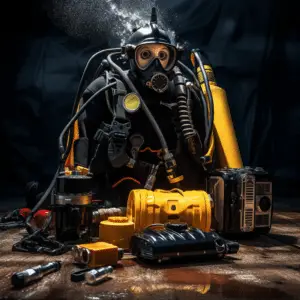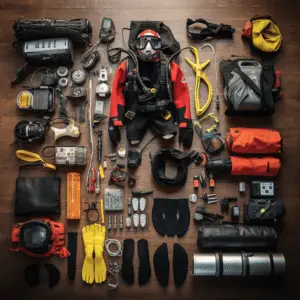Rescue diver equipment, When you think of rescues at the sea, I’m sure you imagine lifeguards in red swimsuits running in slow motion through the sand before a dolphin diving into the water and saving a damsel in distress that is flailing around in the water. Now aside from their signature red swimsuit and the help of a floatation device, lifeguards really don’t need that much equipment for when they need to save someone. However, there are some cases that are way out of the jurisdiction of a lifeguard and these cases require much more equipment.
I am of course referring to the cases that are further out in the sea and cannot be reached by the standard lifeguard. These issues are usually resolved by a rescue diver, but what is a rescue diver and what equipment do they need to use?
What is a Rescue Diver?

A rescue diver is someone that has completed a specific PADI diving course which teaches them how to deal with distressed divers and emergencies out in the water. Rescue divers must recognize when and how to help divers.. Rescue divers are also trained on how to deal with a number of different ailments and what appropriate treatments to give to a number of different medical issues, such as how to deal with the most common symptom of decompression sickness.
What training do rescue divers receive?
PADI rescue certification is required to become a rescue diver. Complete your advanced open water course to learn the basics of diving and how to succeed. After completing that course, you must take Emergency First Responder training. Rescue divers must have first aid training to manage medical difficulties at sea. After completing the initial procedures, you must show your qualifications to the training company. They will verify your certificates and begin the rescue course.
Equipment
Now that you know more about what a rescue diver is, you are probably wondering what equipment they use.
Standard scuba gear
Of course, every rescue diver will first need the standard scuba equipment in order to be able to complete their rescues, these include:
-Mask: This can be a half mask, but rescuers usually use the best full face scuba mask that is available to them, as this lowers equalizing time and combats pressure.
-A regulator.
-Buoyancy control device: To allow the rescuer to ascend to the water faster and also keep a neutral buoyancy.
-An oxygen tank: This is to make sure that anyone completing a rescue has a sufficient amount of oxygen for their own safety.
-Weights: Weights are used to make sure that the rescuer can reach the lower depths of the water faster, meaning they can reach the person in trouble much faster.
-Fins: Fins are helpful when trying to push your way through the water and are helpful for rescue divers that are trying to get to someone in trouble quickly. Fins cut through the water faster and are far more efficient than just swimming.
-Snorkel: The snorkel is more for the benefit of whoever is in trouble as they may not have brought their own and need some support when resurfacing to the water.
-Wetsuit: This may feel like a given, but a wetsuit is important for protecting a rescue diver against any nips and scrapes, along with burns that could occur when in prolonged exposure to the sun.
-Dive computer- A diver computer is essential when it comes to protecting the rescue diver. It tells the diver just how far they have dived and how this correlates with their oxygen consumption.
Additional Equipment that they are required to carry
-A knife: As you may know, thanks to humans, the sea is full of plenty of trash and items that people can get tangled in. This happens quite frequently so it is important to have a sharp object that can be used to cut away any obstructions.
-Torch: The deeper you go into the water, the darker it gets. Because of this, it is important to have an underwater torch so that anything that isn’t very visible can be seen.
-Dive flag: The sea can be a very busy place, so rescue divers always use a diver down the flag to inform anyone passing by that they are there and to avoid the area.
-Signal: A whistle or horn to signal a rescue diver’s location is crucial. Rescue divers usually work in teams, thus they need a signal device to warn other dives to water events.
Boats

Rescue divers never dive without boats. Boats let them go faster and stay put for medical work. Rescue divers store a lot of equipment on their boats since they have greater storage space than humans. Rescue diver boats have this equipment.
-First aid kit:
This is the most obvious bit of equipment and is a must-have on a boat. Rescue divers keep the kit on the boat so they can help people when they return to the boat because they can’t take it in.
-Foil blanket:
A foil blanket on the boat is essential for water rescues because water is cold. Foil blankets speed up heat recovery and avoid hypothermia.
-Buoys:
A lot of the rescues that divers don’t even require them to leave their boat. All rescue boats include buoys so they may be thrown into the sea and stay afloat.
-Oxygen tank:
More seriously, a saved person may lose consciousness underwater. This is harmful and deprives them of air, even with a snorkel. Rescued folks may need an oxygen tank to survive.
-Ropes:
Most rescue services, especially water rescues, need ropes. Sometimes people are straining on the water’s surface, so a rope can pull them to the board. Ropes make rescuing multiple individuals easier.
-Several pocket masks:
Someone in distress may not have their own mask. So keep a supply of pocket masks to take into the water.
